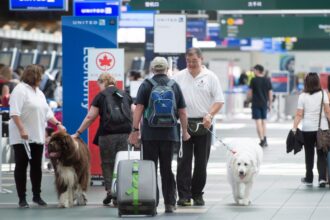A record 1,481 people have been killed since the monsoon rain began in Pakistan on Tuesday, as aid was scrambled to reach those most in need.
Across the country, 54 more deaths were reported in the last 24 hours, with 44 deaths in Sindh’s Khairpur alone. There were eight more deaths reported in Balochistan and two in AJK.
Climate Change Minister Sherry Rehman has warned that rains, which had abated late last month, will continue this week, lashing much of the country.
Continuing the existing monsoon season, the Pakistan Meteorological Department (PMD) forecast another spell of rain in Sindh from Sept 22 through September 15.
There will be Monsoon rain in Tharparkar, Umarkot, Mirpurkhas, Hyderabad, Tando Allahyar, Matiari, and Jamshoro, plus windstorms in Badin, Khairpur, Thatta and Tando Muhammad Khan.
33 million people affected by monsoon rain
There are already 33 million people affected by the floods, and Rehman expressed concern that the downpours would hinder rescue and relief efforts.
Draining flood-hit areas will take up to six months, officials say. Thousands of people have already sickened by waterborne diseases in flood-affected areas – and now dengue fever feared due to mosquito-borne diseases.
Because of stagnant waters following the flooding, mosquitoes have spread. Rehman said the health crisis could cause havoc in the country with 584,246 people in camps. According to her, dengue fever reported in Karachi so far.
Condition of Sindh flood victims
Sindh flood victims – with and without shelter – feared to be at risk of further misery. Khairpur has seen two girls die of gastrointestinal disease as a result of the outbreak of water and vector-borne diseases.
In Qambar and Maher, four children drowned in flood54 more die as Met Office forecasts more rains
waters. There are makeshift camps on the sides of the road in Thatta, Sujawal, and Makli where flood victims are waiting for aid.
About 600,000 people delayed from returning to their villages, towns and other urban areas due to more downpours in Sindh.
Badin’s district administration breached the canal near RD 211 at Zero Point after rising water levels threatened LBOD and its surroundings.
People asked to relocate to safer areas, but many are refusing to do so, protesting against the decision to breach the canal fearing that their villages and crops flooded.
There are still many places where people trapped in water and suffering from dengue and skin diseases, despite the Pakistan Army’s rescue efforts.
Medical camps established in the areas of deployment to address medical issues. Relief supplies shuttled to the camps by army, navy, and air force helicopters.
In Swat, the army conducted relief operations like elsewhere. With the assistance of hovercraft, the Navy helped flood victims relocate to higher ground near Juhi bridge near Khairpur Nathan Shah, Dadu.
Monsoon rain victims protested
There are dozens of people who evacuated from this area, but several refuse to leave their livestock and property. They were also receiving relief materials from the navy.
Relief goods and medical assistance were not provided to flood victims in pockets across the country.
Flood victims protested against the deputy commissioner for lack of relief material near the Kotri Barrage in Jamshoro, suspending traffic from Kotri to Hyderabad.
The protesters also complained about the lack of relief goods and medical assistance in Hyderabad near the SP office.
In the same way, displaced people near Solangi bus stop complained about food and shelter shortages on Thatta-Sujawal Road.
Under the open sky, they exposed to rain and mosquitoes. In the absence of food and milk, children forced to drink dirty contaminated water, putting their health at risk.
There are complaints all over the country where displaced people live along highways and on higher ground. There was a similar situation at Rojhan Toll Plaza near the Sindh-Punjab-Balochistan border on the Indus Highway.
In the aftermath of floods, hundreds of displaced people are living in this large village on both sides of the Indus Highway. Local Mazari Sardars and PTI MPs refused to provide any assistance during the crisis, which frustrated the locals.
Government’s efforts for flood victims
They complained that the Mazari sardars created a breach to save their own land by flooding the land of commoners. “Desperate times call for desperate measures,” AC Rojhan Zeeshan Sharif Qaisarani said.
In the meantime, Prime Minister Muhammad Shehbaz Sharif stressed the need to de-water national highways and rail networks. As the water receded, he directed strict monitoring of flood-affected areas where water-borne diseases could spread.
In flood-affected areas, the prime minister chaired a high-level meeting to review rescue, relief, and rehabilitation activities.
Coordination and efforts were the key to restoring power supply infrastructure, road networks, and telecommunications systems in flood-affected areas, according to the prime minister.
After clearing a landslide at Wangu Hills, the operational sections of Gwadar-Ratodero Motorway M-8 are now open. Bajaur and Munda Grid Stations continue operating as normal as well as the Timergara-Bajaur transmission line.














[…] WHO is concerned for flood affectees? […]
[…] A second round of Monsoon rain kills 820 in Pakistan […]